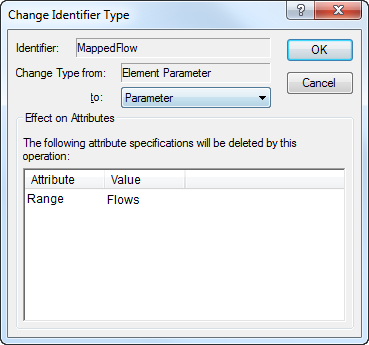Committing attribute changes
Syntax checking
The modifications that you make to the attributes of a declaration are initially only stored locally within the form. Once you take further action, the changes in your model will be checked syntactically and committed to the model. There are three ways to do this.
Saving the model
In addition to committing the changes in a single attribute form manually as above, the changes that you have made in any attribute form are also committed when you save the model (through the File-Save menu), or recompile it in its entirety (through the Run-Compile All menu).
Renaming identifiers
It is quite common to rename an existing identifier in a modeling application because you consider that a new name would better express its intention. In such cases, you should be aware of the possible consequences for your application. The following questions are relevant.
Are there references to the (old) identifier name in other parts of the model?
Are there case files that contain data with respect to the (old) identifier name?
Are there pages in the end-user interface that display data with respect to the (old) identifier name?
If the answer to any of these questions is yes, then changing the identifier name could create problems.
Automatic name changes
AIMMS helps you in dealing with the possible consequences of name changes by offering the following support:
AIMMS updates all references to the identifier throughout the model text, and in addition,
AIMMS keeps a log of the name change (see also Additional files related to an AIMMS project), so that when AIMMS encounters any reference to the old name in either a page or in a case file, the new name will be substituted.
Beware of structural changes
Problems arise when you want to change the index domain of an identifier, or remove an identifier, while it is still referenced somewhere in your application. Such changes are called structural, and are likely to cause errors in pages and cases. In general, these errors cannot be recovered automatically. To help you locate possible problem areas, AIMMS will mark all pages and cases that contain references to changed or deleted identifiers. To check how a change really affects these pages and cases, you should open them, make any required adaptations to deal with the errors, and resave them.
Modifying identifier type
You can modify the type of a particular identifier in the model tree via
the identifier type drop-down list  in the attribute window
of the identifier. The drop-down list lets you select from all
identifier types that are compatible with the current identifier type.
Alternatively, you can change the identifier type via the Edit-Change
Type menu.
in the attribute window
of the identifier. The drop-down list lets you select from all
identifier types that are compatible with the current identifier type.
Alternatively, you can change the identifier type via the Edit-Change
Type menu.
Incompatible attributes
Before a change of identifier type is actually committed, AIMMS displays the dialog box illustrated in Fig. 21, which lists all the attributes of the identifier that are not compatible with the newly selected type.

Fig. 21 The Change Identifier Type dialog box
If you do not want such attributes to be deleted, you should cancel the operation at this point. When you allow AIMMS to actually perform the type change, the incompatible attributes will be deleted.